Dynamic Serpentine Convolution with Attention Mechanism Enhancement for Beef Cattle Behavior Recognition
Abstract
Simple Summary
Abstract
1. Introduction
- (1)
- Theoretical Objectives: To establish a more comprehensive dataset for beef cattle posture and enhance the model’s recognition performance by improving the convolution modules and incorporating attention modules on the basis of the YOLOv8 algorithm;
- (2)
- Practical Objectives: To enhance the model’s accuracy in recognizing beef cattle behavior in complex scenarios such as strong light, low light, moderate density, and high density through both dataset augmentation and algorithm optimization. This aims to provide a practical foundation for subsequent applications, including beef cattle disease early warning and intelligent farming.
2. Materials and Methods
2.1. Dataset
2.1.1. Collection of Dataset
- Quantity of Livestock: The maximum number of beef cattle in this enclosure does not exceed 100.
- Average Activity Area for Beef Cattle: The dimensions of the cattle enclosure allow for a simple calculation indicating that the average activity area per beef cattle is not less than 24.3 square meters.
- Feeding and Water Access: Beef cattle are fed at around 5:30 a.m. and 6:00 p.m., with two feedings per day. Water for the cattle is freely accessible in the designated water area.
- Ventilation Conditions and Livestock Environment: Natural ventilation is employed, and the environment for beef cattle rearing is in its original state without any special padding.
2.1.2. Data Preprocessing and Enhancement
2.2. Principle of the YOLOv8 Algorithm
2.3. The Improvement of YOLO Algorithm
2.3.1. Introducing the Dynamic Serpentine Convolution DSConv Module
2.3.2. Introducing the Dynamic Serpentine Convolution DSConv Module
3. Results and Analysis
3.1. Experimental Environment
3.2. Model Evaluation
3.3. Introducing Dynamic Serpentine Convolution Recognition Results
3.4. Introducing Dynamic Serpentine Convolution Recognition Results
3.5. Results and Analysis of Ablation Experiment
3.6. Comparative Analysis with Other Models
3.7. YOLOv8n_BiF_DSC Test Results
3.8. Model Visualization Analysis
3.9. Comparison of Recognition Effects of Different Scene Models
3.9.1. Different Lighting Environments
3.9.2. Different Intensities
4. Discussions
5. Conclusions
- (1)
- In terms of the dataset, this study provides a more extensive range of beef cattle behaviors compared to similar researchers. It includes nine types of beef cattle behaviors: standing, lying, mounting, fighting, licking, eating, drinking, walking, and searching. Additionally, the dataset covers more complex scenarios, such as low lighting, strong lighting, normal lighting, dense populations, sparse populations, and small targets at long distances. This comprehensive dataset closely reflects the actual breeding conditions of beef cattle, providing robust data support for modernized cattle farming and early warning systems.
- (2)
- In terms of algorithms, this study introduces a novel and efficient YOLOv8n_BiF_DSC algorithm for the non-intrusive recognition of beef cattle behavior. The algorithm incorporates the following improvements: the introduction of dynamic snake-form convolution modules to enhance feature extraction capabilities, expand the receptive field, and strengthen model robustness; the integration of the BiFormer attention mechanism to dynamically and sparsely learn critical features, improving the average accuracy of beef cattle posture recognition under typical conditions, as well as addressing challenges like missed detections, false positives, and low confidence in complex scenarios such as dense cattle populations, long distances, and small targets.
- (3)
- In practical scenarios involving beef cattle in low light, strong light, dense groups, and sparse groups, the YOLOv8n_BiF_DSC algorithm achieves a recognition accuracy of 93.6% and an average precision of 96.5% at thresholds of 50, 95, and 71.5%, respectively. This represents improvements of 5.3%, 5.2%, and 7.1% over the original YOLOv8n. The algorithm also outperforms other state-of-the-art algorithms, providing technical support for the intelligent recognition and management of beef cattle behavior.
Author Contributions
Funding
Institutional Review Board Statement
Informed Consent Statement
Data Availability Statement
Acknowledgments
Conflicts of Interest
References
- Reyes, F.S.; White, H.M.; Weigel, K.A.; Van Os, J.M. Preference for feed bins shared with cows of the same or different parity and relationships with feeding behavior and feed efficiency. J. Dairy Sci. 2024. [Google Scholar] [CrossRef] [PubMed]
- Shi, G.; Shen, X.; Xiao, F.; He, Y. DANTD: A Deep Abnormal Network Traffic Detection Model for Security of Industrial Internet of Things Using High-order Features. IEEE Internet Things J. 2023, 10, 21143–21153. [Google Scholar] [CrossRef]
- Bai, Q.; Gao, R.; Wang, R.; Li, Q.; Yu, Q.; Zhao, C.; Li, S. X3DFast model for classifying dairy cow behaviors based on a two-pathway architecture. Sci. Rep. 2023, 13, 20519. [Google Scholar] [CrossRef] [PubMed]
- Li, G.; Shi, G.; Jiao, J. YOLOv5-KCB: A New Method for Individual Pig Detection Using Optimized K-Means, CA Attention Mechanism and a Bi-Directional Feature Pyramid Network. Sensors 2023, 23, 5242. [Google Scholar] [CrossRef] [PubMed]
- Neave, H.W.; Jensen, E.H.; Durrenwachter, M.; Jensen, M.B. Behavioral responses of dairy cows and their calves to gradual or abrupt weaning and separation when managed in full-or part-time cow-calf contact systems. J. Dairy Sci. 2023, in press. [Google Scholar] [CrossRef]
- Li, J.; Kang, F.; Zhang, Y.; Liu, Y.; Yu, X. Research on Tracking and Identification of Typical Protective Behavior of Cows Based on DeepLabCut. Appl. Sci. 2023, 13, 1141. [Google Scholar] [CrossRef]
- Barker, Z.E.; Diosdado, J.A.V.; Codling, E.A.; Bell, N.J.; Hodges, H.R.; Croft, D.P.; Amory, J.R. Use of novel sensors combining local positioning and acceleration to measure feeding behavior differences associated with lameness in dairy cattle. J. Dairy Sci. 2018, 101, 6310–6321. [Google Scholar] [CrossRef]
- Benaissa, S.; Tuyttens, F.A.M.; Plets, D.; Cattrysse, H.; Martens, L.; Vandaele, L.; Joseph, W.; Sonck, B. Classification of ingestive-related cow behaviours using RumiWatch halter and neck-mounted accelerometers. Appl. Anim. Behav. Sci. 2019, 211, 9–16. [Google Scholar] [CrossRef]
- Ma, S.; Zhang, Q.; Li, T.; Song, H. Basic motion behavior recognition of single dairy cow based on improved Rexnet 3D network. Comput. Electron. Agric. 2022, 194, 106772. [Google Scholar] [CrossRef]
- Islam, M.N.; Yoder, J.; Nasiri, A.; Burns, R.T.; Gan, H. Analysis of the drinking behavior of beef cattle using computer vision. Animals 2023, 13, 2984. [Google Scholar] [CrossRef]
- Hao, W.; Ren, C.; Han, M.; Zhang, L.; Li, F.; Liu, Z. Cattle Body Detection Based on YOLOv5-EMA for Precision Livestock Farming. Animals 2023, 13, 3535. [Google Scholar] [CrossRef]
- Yang, W.; Wu, J.; Zhang, J.; Gao, K.; Du, R.; Wu, Z.; Firkat, E.; Li, D. Deformable convolution and coordinate attention for fast cattle detection. Comput. Electron. Agric. 2023, 211, 108006. [Google Scholar] [CrossRef]
- Zheng, Z.; Qin, L. PrunedYOLO-Tracker: An efficient multi-cows basic behavior recognition and tracking technique. Comput. Electron. Agric. 2023, 213, 108172. [Google Scholar] [CrossRef]
- Wang, Y.; Li, R.; Wang, Z.; Hua, Z.; Jiao, Y.; Duan, Y.; Song, H. E3D: An efficient 3D CNN for the recognition of dairy cow’s basic motion behavior. Comput. Electron. Agric. 2023, 205, 107607. [Google Scholar] [CrossRef]
- Shang, C.; Wu, F.; Wang, M.L.; Gao, Q. Cattle behavior recognition based on feature fusion under a dual attention mechanism. J. Vis. Commun. Image Represent. 2022, 85, 103524. [Google Scholar] [CrossRef]
- Shu, H.; Bindelle, J.; Guo, L.; Gu, X. Determining the onset of heat stress in a dairy herd based on automated behaviour recognition. Biosyst. Eng. 2023, 226, 238–251. [Google Scholar] [CrossRef]
- Lee, T.; Na, Y.; Kim, B.G.; Lee, S.; Choi, Y. Identification of Individual Hanwoo Cattle by Muzzle Pattern Images through Deep Learning. Animals 2023, 13, 2856. [Google Scholar] [CrossRef]
- Tassinari, P.; Bovo, M.; Benni, S.; Franzoni, S.; Poggi, M.; Mammi, L.M.E.; Mattoccia, S.; Stefano, L.D.; Bonora, F.; Barbaresi, A.; et al. A computer vision approach based on deep learning for the detection of dairy cows in free stall barn. Comput. Electron. Agric. 2021, 182, 106030. [Google Scholar] [CrossRef]
- Brunet, D.; Vrscay, E.R.; Wang, Z. On the mathematical properties of the structural similarity index. IEEE Trans. Image Process. 2011, 21, 1488–1499. [Google Scholar] [CrossRef]
- Redmon, J.; Divvala, S.; Girshick, R.; Farhadi, A. You only look once: Unified, real-time object detection. In Proceedings of the 2016 IEEE Conference on Computer Vision and Pattern Recognition (CVPR), Las Vegas, NV, USA, 27–30 June 2016; IEEE: Piscataway, NJ, USA, 2016; pp. 779–788. [Google Scholar]
- Redmon, J.; Farhadi, A. YOLO9000: Better, faster, stronger. In Proceedings of the 2017 IEEE Conference on Computer Vision and Pattern Recognition (CVPR), Honolulu, HI, USA, 21–26 July 2017; IEEE: Piscataway, NJ, USA, 2017; pp. 6517–6525. [Google Scholar]
- Redmon, J.; Farhadi, A. Yolov3: An incremental improvement. arXiv 2018, arXiv:1804. 02767. [Google Scholar]
- Bochkovskiy, A.; Wang, C.Y.; Liao, H.Y.M. YOLOv4: Optimal speed and accuracy of object detection. arXiv 2020, arXiv:2004.10934. [Google Scholar]
- Wang, C.Y.; Bochkovskiy, A.; Liao, H.Y.M. YOLOv7: Trainable bag-of-freebies sets new state-of-the-art for real-time object detectors. In Proceedings of the IEEE/CVF Conference on Computer Vision and Pattern Recognition, Vancouver, BC, Canada, 18–22 June 2023; pp. 7464–7475. [Google Scholar]
- Dai, J.; Qi, H.; Xiong, Y.; Li, Y.; Zhang, G.; Hu, H.; Wei, Y. Deformable convolutional networks. In Proceedings of the IEEE International Conference on Computer Vision, Venice, Italy, 22–29 October 2017; pp. 764–773. [Google Scholar]
- Qi, Y.; He, Y.; Qi, X.; Zhang, Y.; Yang, G. Dynamic snake convolution based on topological geometric constraints for tubular structure segmentation. In Proceedings of the IEEE/CVF International Conference on Computer Vision, Paris, France, 2–3 October 2023; pp. 6070–6079. [Google Scholar]
- Zhu, L.; Wang, X.; Ke, Z.; Zhang, W.; Lau, R.W. BiFormer: Vision Transformer with Bi-Level Routing Attention. In Proceedings of the IEEE/CVF Conference on Computer Vision and Pattern Recognition, Vancouver, BC, Canada, 18–22 June 2023; pp. 10323–10333. [Google Scholar]
- Dosovitskiy, A.; Beyer, L.; Kolesnikov, A.; Weissenborn, D.; Zhai, X.; Unterthiner, T.; Houlsby, N. An image is worth 16 × 16 words: Transformers for image recognition at scale. arXiv 2020, arXiv:2010.11929. [Google Scholar]
- Liu, N.; Qi, J.; An, X.; Wang, Y. A Review on Information Technologies Applicable to Precision Dairy Farming: Focus on Behavior, Health Monitoring, and the Precise Feeding of Dairy Cows. Agriculture 2023, 13, 1858. [Google Scholar] [CrossRef]
- Gao, G.; Wang, C.; Wang, J.; Lv, Y.; Li, Q.; Ma, Y.; Chen, G. CNN-Bi-LSTM: A complex environment-oriented cattle behavior classification network based on the fusion of CNN and Bi-LSTM. Sensors 2023, 23, 7714. [Google Scholar] [CrossRef]
- Jie, H.; Li, S.; Gang, S. Squeeze-and-Excitation Networks. In Proceedings of the IEEE Conference on Computer Vision and Pattern Recognition (CVPR), Salt Lake City, UT, USA, 18–22 June 2018; IEEE Press: New York, NY, USA, 2018; Volume 7, pp. 7132–7141. [Google Scholar]
- Woo, S.; Park, J.; Lee, J.Y.; Kweon, I.S. CBAM: Convolutional Block Attention Module. In Proceedings of the European Conference on Computer Vision (ECCV), Munich, Germany, 8–14 September 2018; Volume 11211, pp. 3–19. [Google Scholar]
- Hou, Q.; Zhou, D.; Feng, J. Coordinate attention for efficient mobile network design. In Proceedings of the IEEE/CVF Conference on Computer Vision and Pattern Recognition, Nashville, TN, USA, 20–25 June 2021; pp. 13713–13722. [Google Scholar]
- Ren, S.; He, K.; Girshick, R.; Sun, J. Faster r-cnn: Towards real-time object detection with region proposal networks. Adv. Neural Inf. Process. Syst. 2015, 28. [Google Scholar]
- Ge, Z.; Liu, S.; Wang, F.; Li, Z.; Sun, J. Yolox: Exceeding yolo series in 2021. arXiv 2021, arXiv:2107.08430. [Google Scholar]
- Chattopadhay, A.; Sarkar, A.; Howlader, P.; Balasubramanian, V.N. Grad-cam++: Generalized gradient-based visual explanations for deep convolutional networks. In Proceedings of the 2018 IEEE Winter Conference on Applications of Computer Vision (WACV), Lake Tahoe, NV, USA, 12–15 March 2018; IEEE: Piscataway, NJ, USA, 2018; pp. 839–847. [Google Scholar]
- Jingqiu, G.; Zhihai, W.; Ronghua, G.; Huarui, W. Cow behavior recognition based on image analysis and activities. Int. J. Agric. Biol. Eng. 2017, 10, 165–174. [Google Scholar]
- Wu, D.; Wang, Y.; Han, M.; Song, L.; Shang, Y.; Zhang, X.; Song, H. Using a CNN-LSTM for basic behaviors detection of a single dairy cow in a complex environment. Comput. Electron. Agric. 2021, 182, 106016. [Google Scholar] [CrossRef]
- Zhang, Y.; Ibrayim, M.; Hamdulla, A. Research on Cow Behavior Recognition Based on Improved SlowFast with 3DCBAM. In Proceedings of the 2023 5th International Conference on Communications, Information System and Computer Engineering (CISCE), Guangzhou, China, 14–16 April 2023; IEEE: Piscataway, NJ, USA, 2023; pp. 470–475. [Google Scholar]
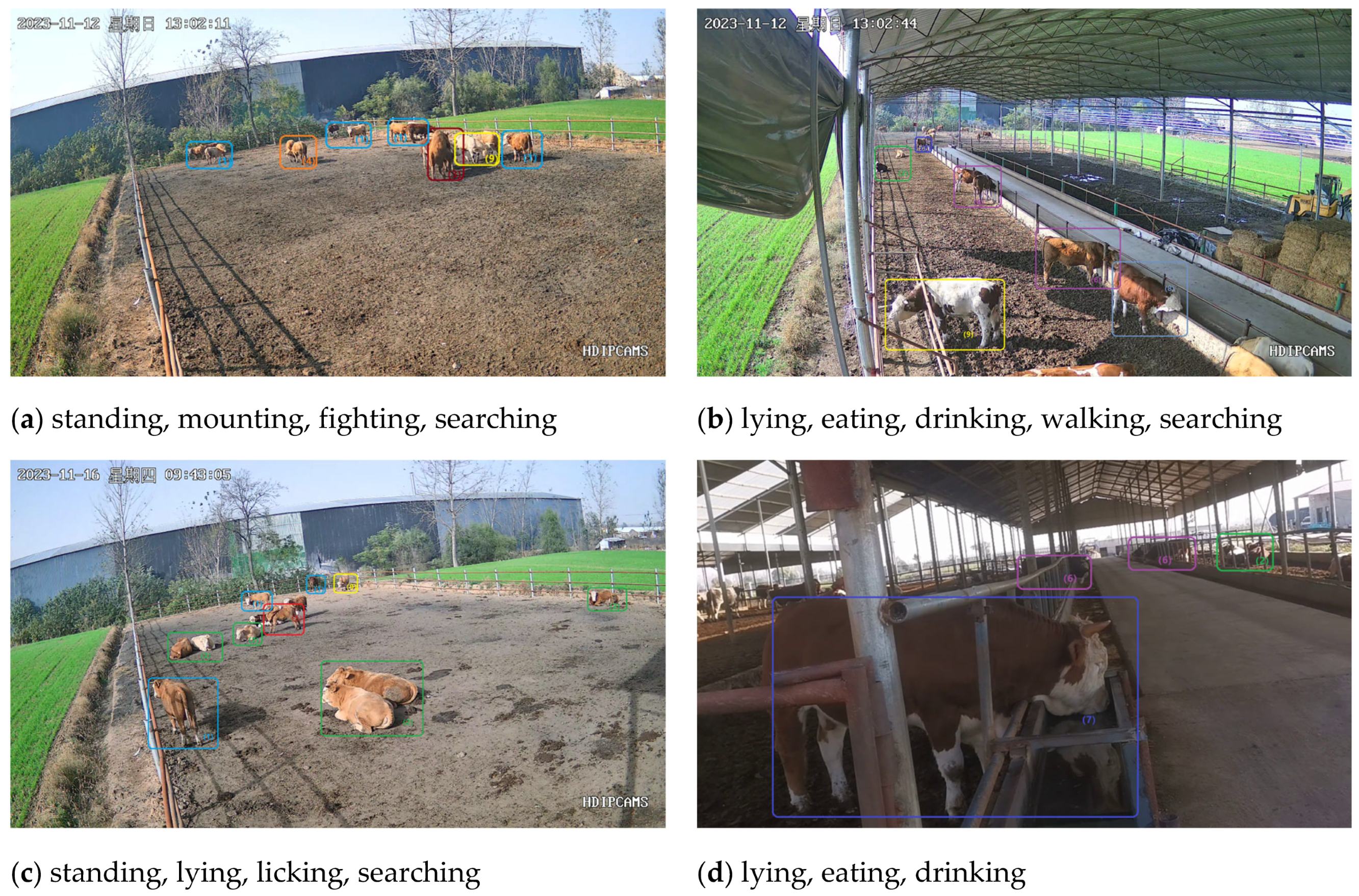
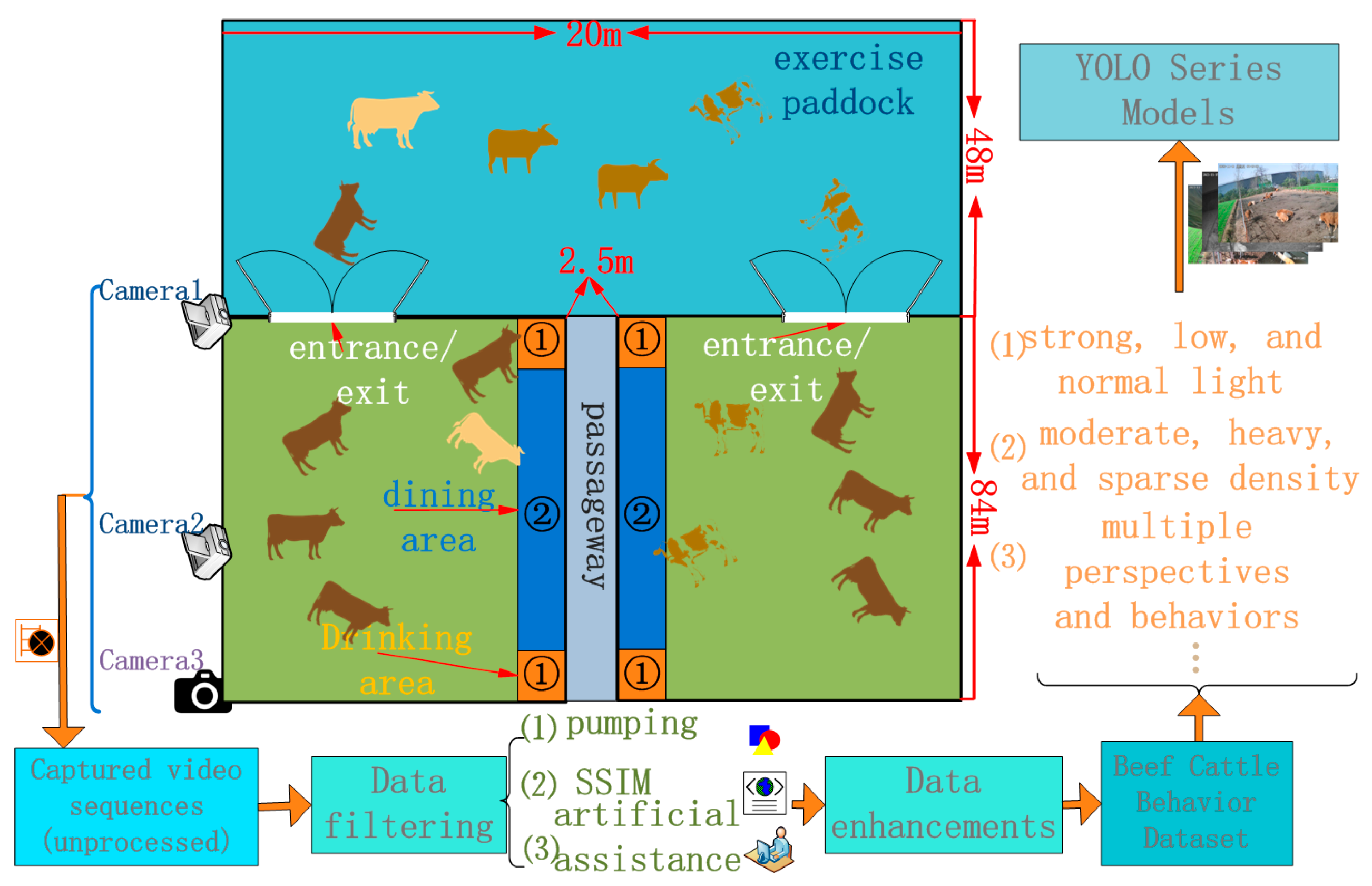
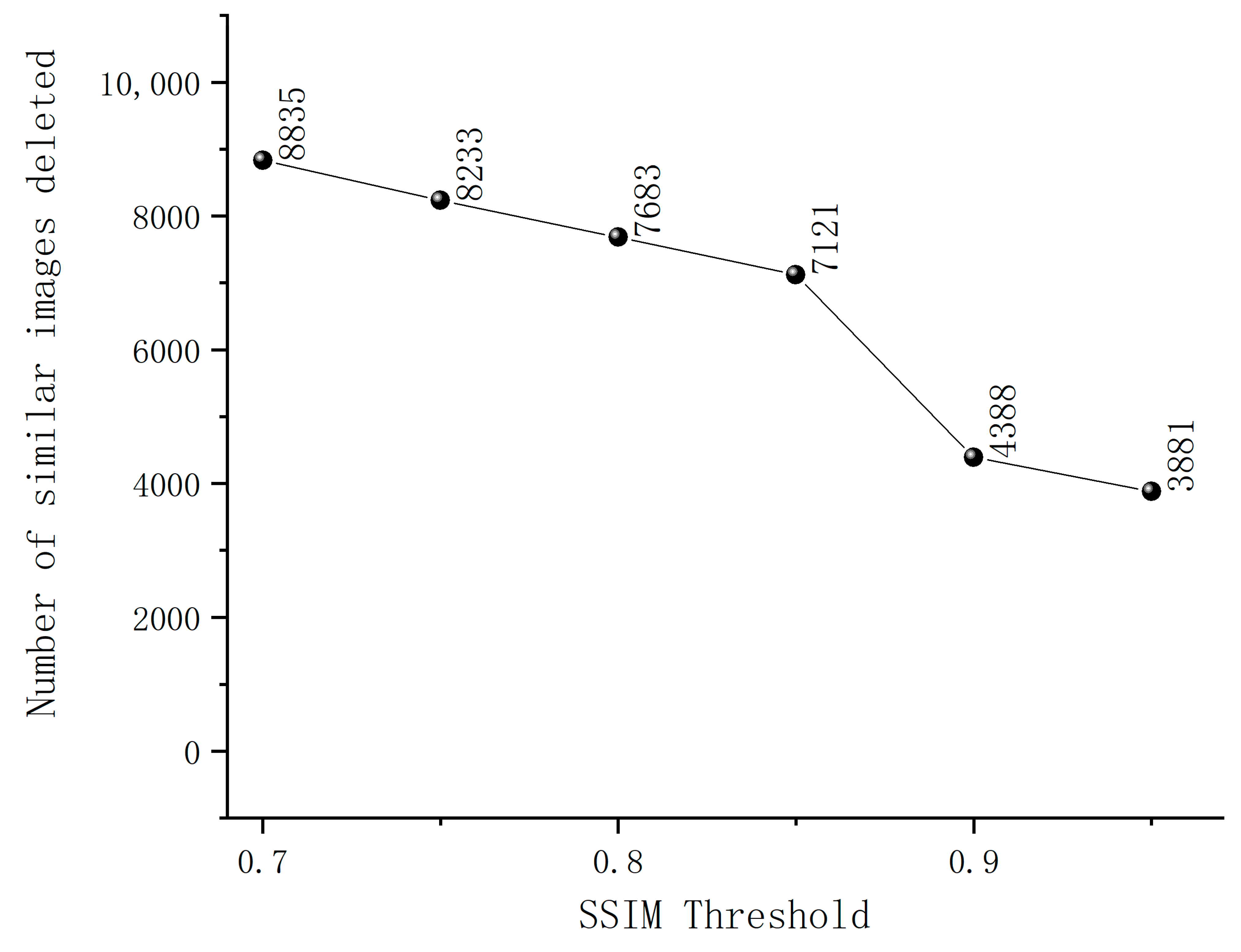
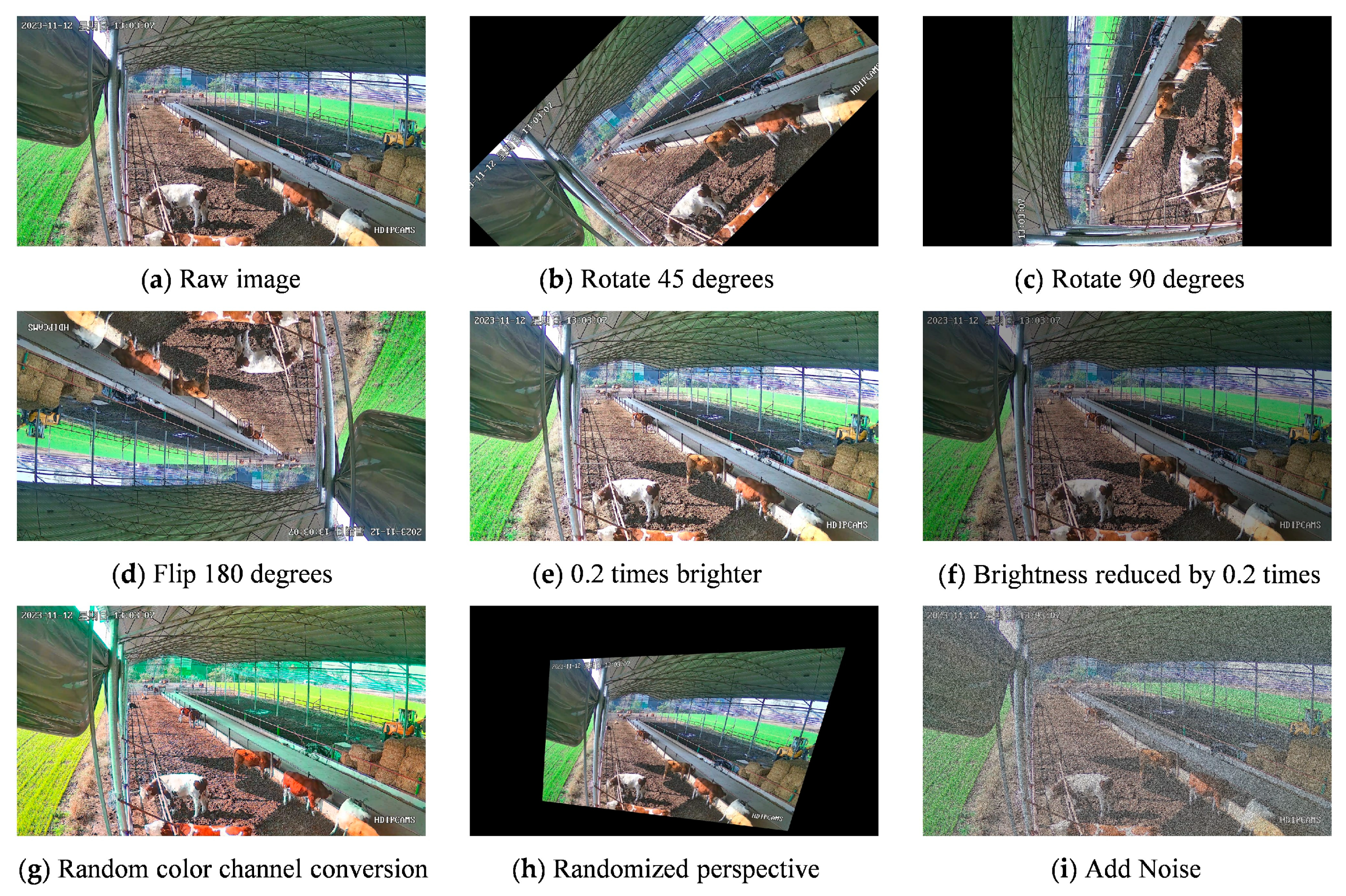
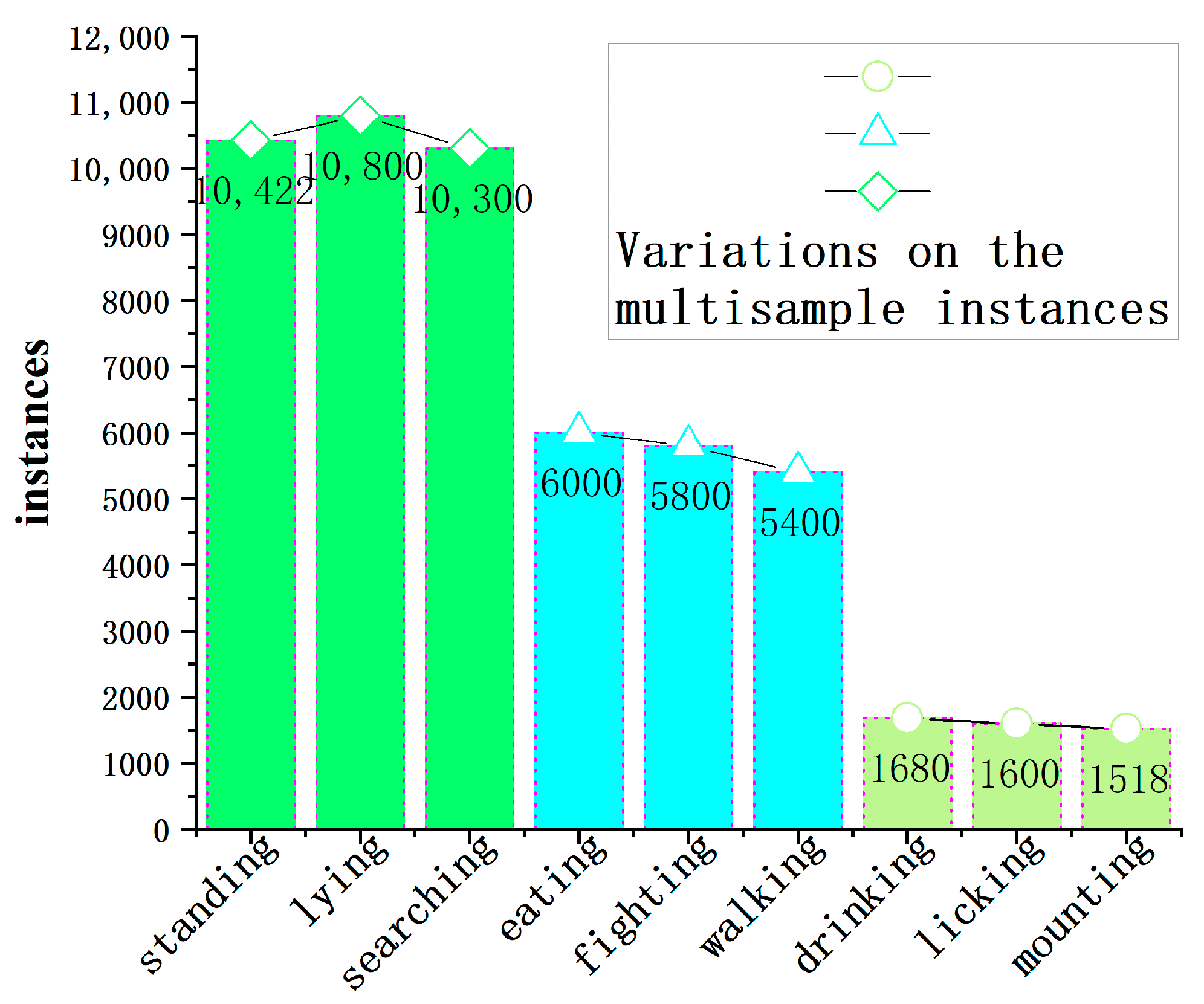
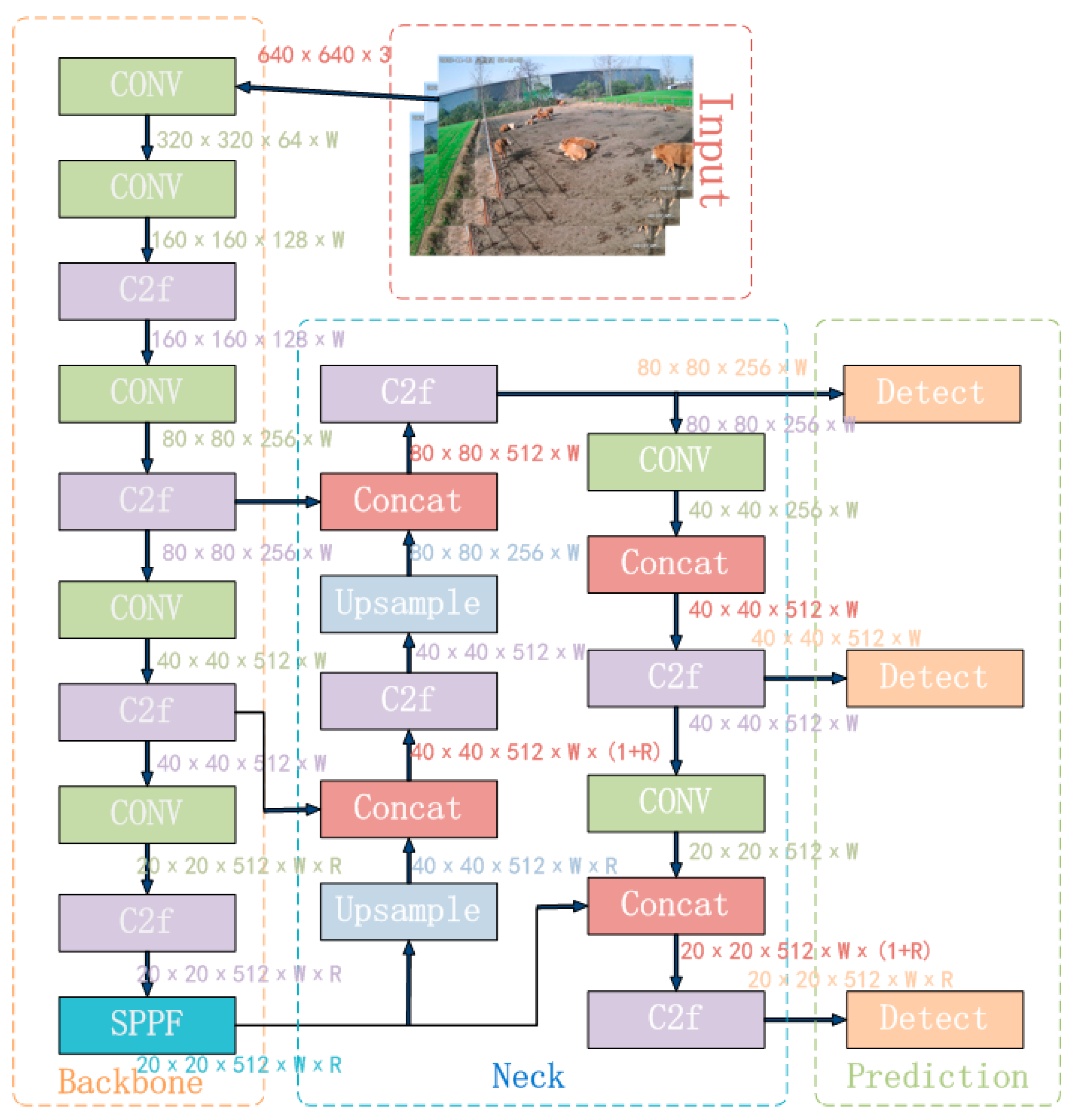

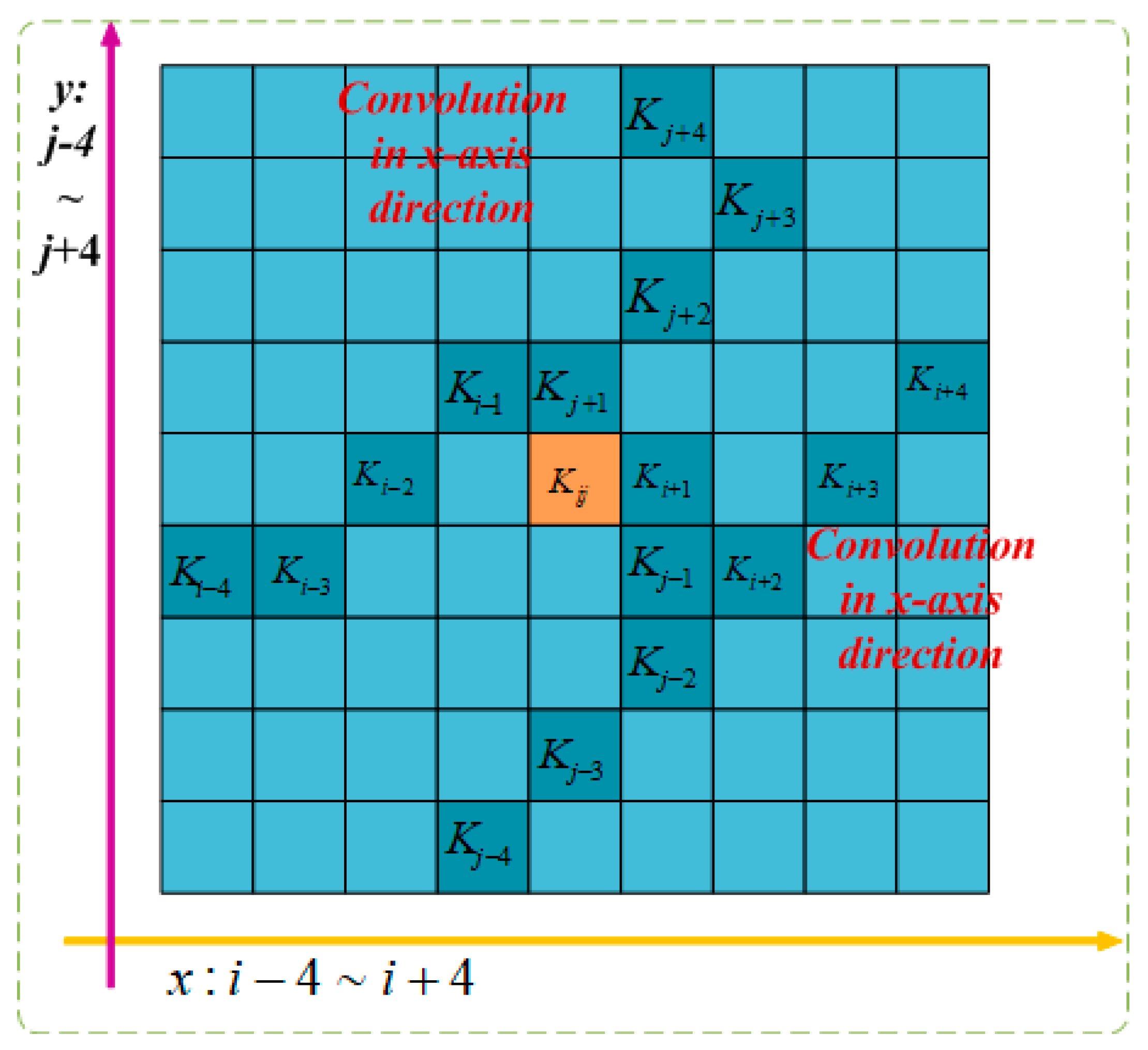



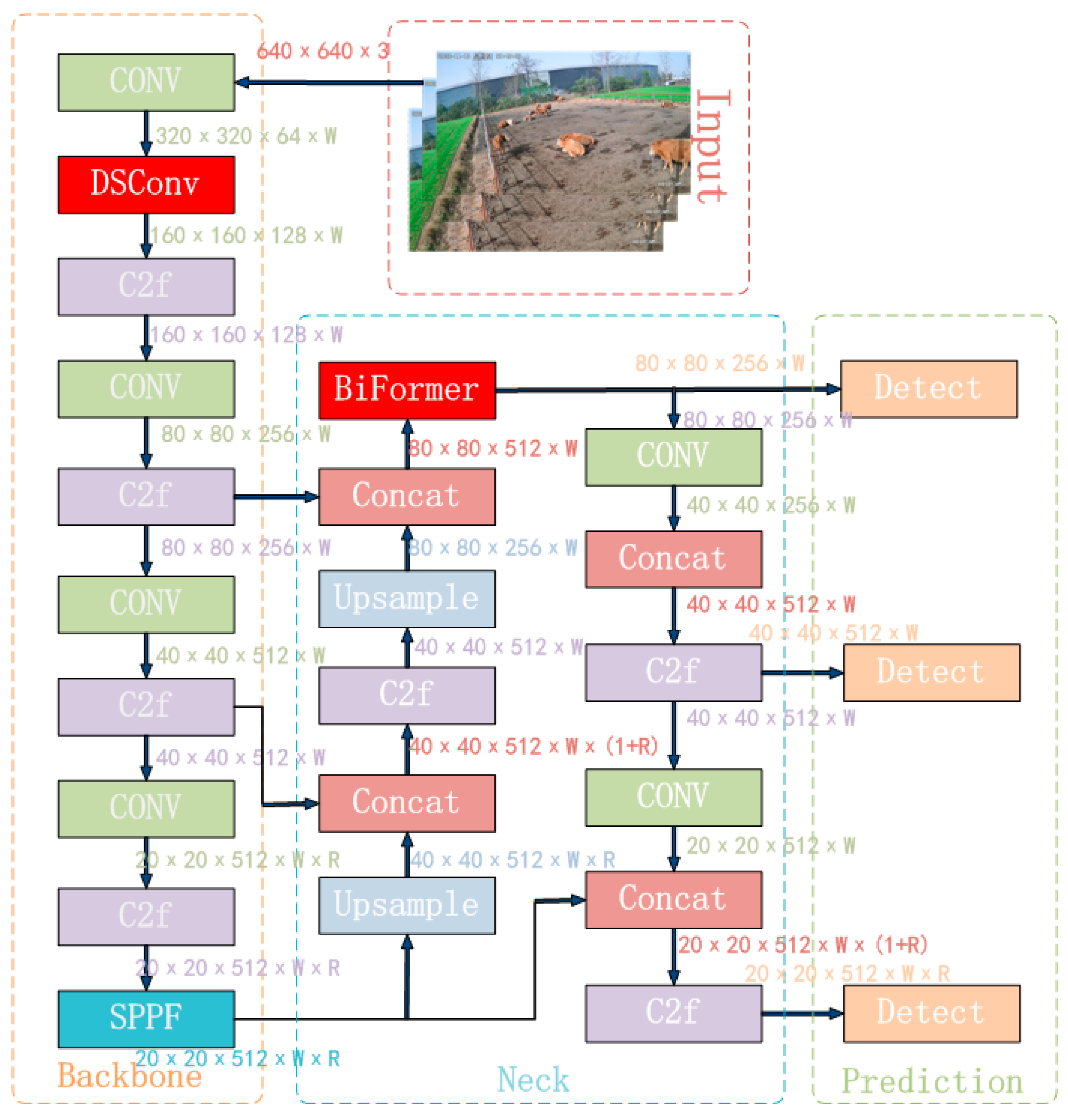
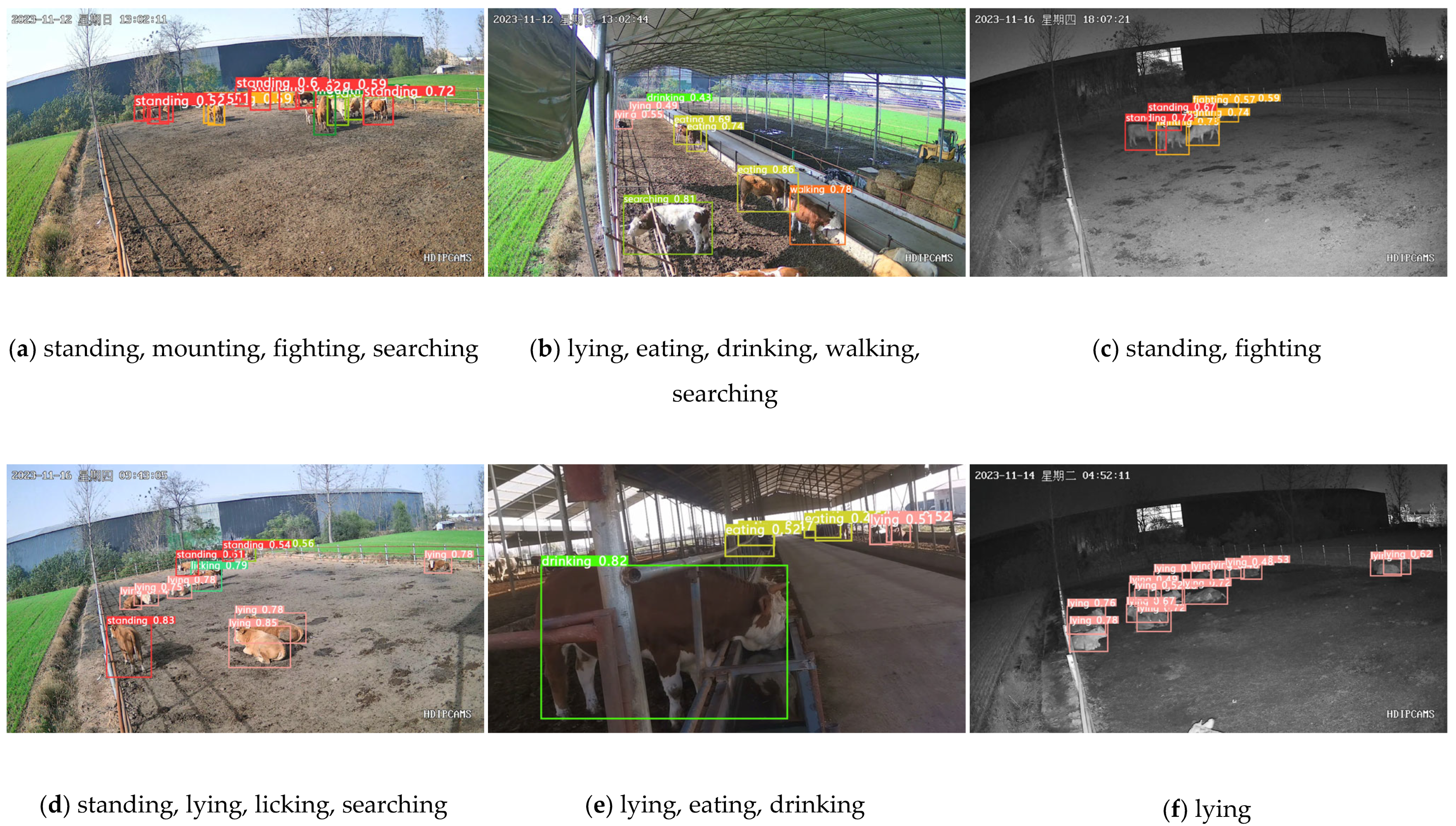
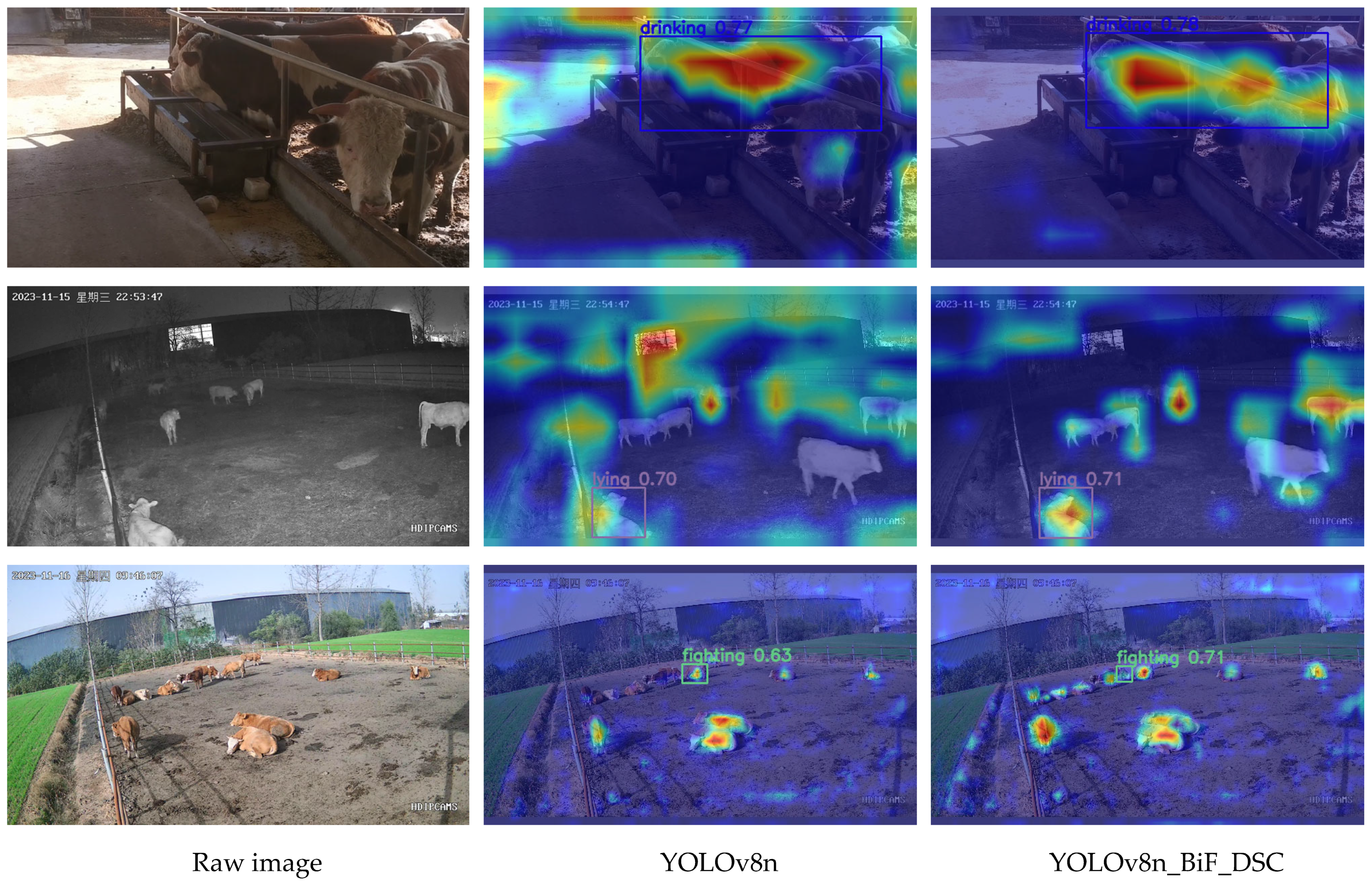
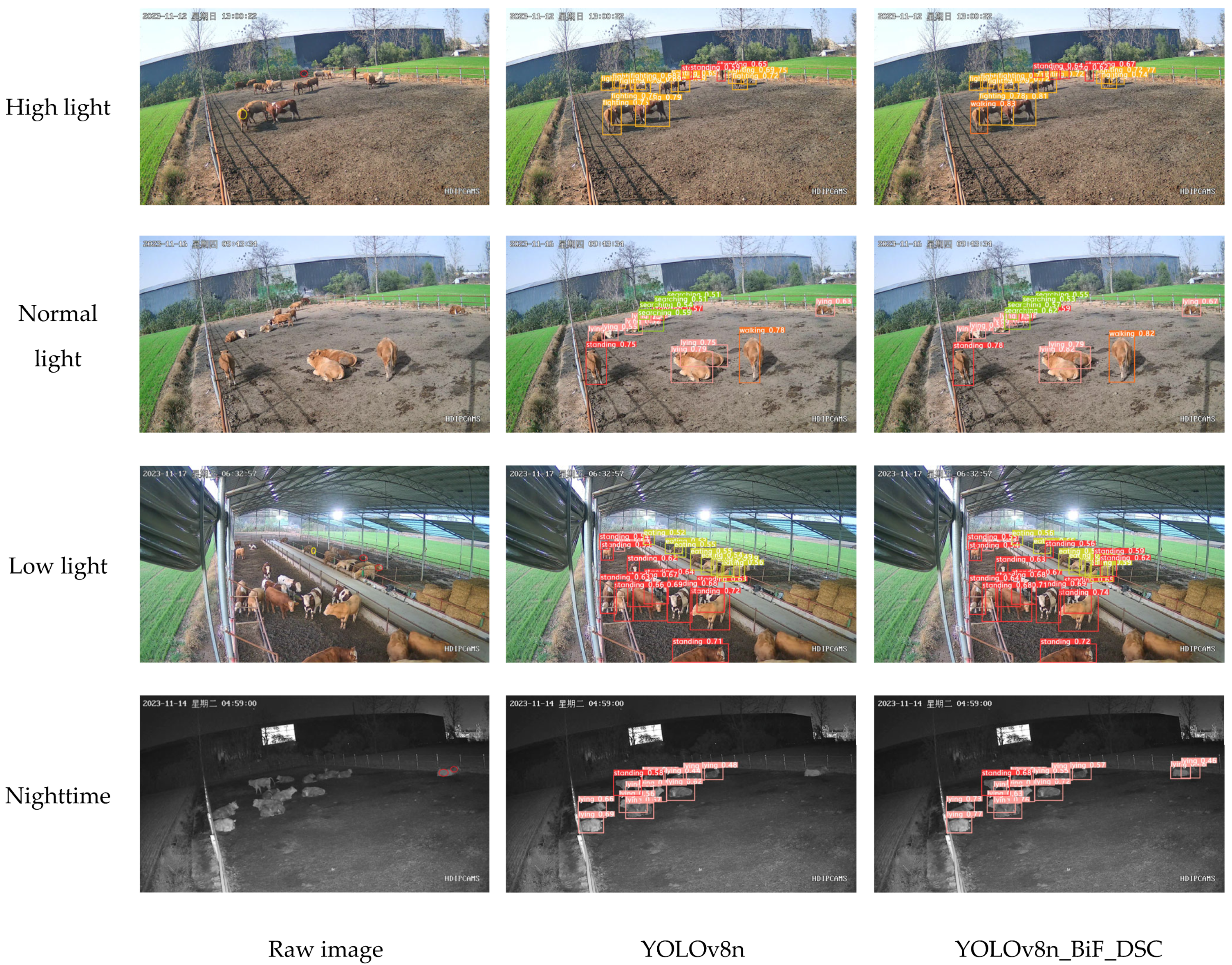



| Behavior Number | Behavioral Categories/Labels | Behavioral Description | Instances |
|---|---|---|---|
| (1) | standing | Supported by 4 cow legs, cow head not touching the ground | 10,422 |
| (2) | lying | Legs bent and touching the ground or body touching the ground | 10,800 |
| (3) | mounting | A cow’s front hooves resting on another cow’s back loin | 1518 |
| (4) | fighting | 2 or more bulls headbutting each other | 5800 |
| (5) | licking | Tongue makes contact in sweeping motion repeatedly with another cow | 1600 |
| (6) | eating | Cow’s head enters the trough | 6000 |
| (7) | drinking | Cow’s head into the water trough | 1680 |
| (8) | walking | 4 cow legs displaced from the body, cow’s head not touching the ground | 5400 |
| (9) | searching | Cow’s head near or touching the ground | 10,300 |
| Software and Hardware | Parameters |
|---|---|
| CPU | Intel Core i7-13700F 3.0 GHz |
| Opencv | 4.8.0.76 |
| CUDA | 12.1 |
| Cudnn | 8700 |
| GPU | NVIDIAGeForce RTX4070(NVIDIA Corporation, Santa Clara, CA, USA) |
| Operating system | Windows11 |
| Frameworks | Pytorch 2.0.0 |
| Model | P | R | mAP50 | mAP50:95 |
|---|---|---|---|---|
| YOLOv8n | 0.883 | 0.866 | 0.913 | 0.644 |
| YOLOv8n_DC | 0.917 | 0.891 | 0.939 | 0.671 |
| YOLOv8n_DSC | 0.933 | 0.894 | 0.945 | 0.677 |
| Model | P | R | mAP50 | mAP50:95 |
|---|---|---|---|---|
| YOLOv8n | 0.883 | 0.866 | 0.913 | 0.644 |
| YOLOv8n_SE | 0.872 | 0.888 | 0.91 | 0.639 |
| YOLOv8n_CBAM | 0.911 | 0.897 | 0.926 | 0.656 |
| YOLOv8n_CA | 0.915 | 0.901 | 0.932 | 0.664 |
| Model | DSC | BiF | P | R | mAP50 | mAP50:95 |
|---|---|---|---|---|---|---|
| YOLOv8n | - | - | 0.883 | 0.866 | 0.913 | 0.644 |
| YOLOv8n_DSC | √ | - | 0.933 | 0.894 | 0.945 | 0.677 |
| YOLOv8n_BiF | - | √ | 0.922 | 0.931 | 0.94 | 0.672 |
| YOLOv8n_BiF_DSC | √ | √ | 0.936 | 0.929 | 0.965 | 0.715 |
| Model | P | R | mAP50 | mAP50:95 |
|---|---|---|---|---|
| FastRCN | 0.862 | 0.843 | 0.879 | 0.605 |
| YOLOX | 0.869 | 0.859 | 0.901 | 0.639 |
| YOLOv7 | 0.87 | 0.862 | 0.911 | 0.642 |
| YOLOv8n_BiF_DSC | 0.936 | 0.929 | 0.965 | 0.715 |
Disclaimer/Publisher’s Note: The statements, opinions and data contained in all publications are solely those of the individual author(s) and contributor(s) and not of MDPI and/or the editor(s). MDPI and/or the editor(s) disclaim responsibility for any injury to people or property resulting from any ideas, methods, instructions or products referred to in the content. |
© 2024 by the authors. Licensee MDPI, Basel, Switzerland. This article is an open access article distributed under the terms and conditions of the Creative Commons Attribution (CC BY) license (https://creativecommons.org/licenses/by/4.0/).
Share and Cite
Li, G.; Shi, G.; Zhu, C. Dynamic Serpentine Convolution with Attention Mechanism Enhancement for Beef Cattle Behavior Recognition. Animals 2024, 14, 466. https://doi.org/10.3390/ani14030466
Li G, Shi G, Zhu C. Dynamic Serpentine Convolution with Attention Mechanism Enhancement for Beef Cattle Behavior Recognition. Animals. 2024; 14(3):466. https://doi.org/10.3390/ani14030466
Chicago/Turabian StyleLi, Guangbo, Guolong Shi, and Changjie Zhu. 2024. "Dynamic Serpentine Convolution with Attention Mechanism Enhancement for Beef Cattle Behavior Recognition" Animals 14, no. 3: 466. https://doi.org/10.3390/ani14030466
APA StyleLi, G., Shi, G., & Zhu, C. (2024). Dynamic Serpentine Convolution with Attention Mechanism Enhancement for Beef Cattle Behavior Recognition. Animals, 14(3), 466. https://doi.org/10.3390/ani14030466






